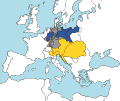ผลต่างระหว่างรุ่นของ "อุดมการณ์รวมกลุ่มเยอรมัน"
ไม่มีความย่อการแก้ไข |
ไม่มีความย่อการแก้ไข |
||
| บรรทัด 9: | บรรทัด 9: | ||
<gallery> |
<gallery> |
||
ไฟล์:Map-GermanConfederation.svg|The [[German Confederation]] in 1820. Territories of the [[Kingdom of Prussia|Prussian crown]] are blue, territories of the [[Austrian Empire|Austrian crown]] are yellow, and independent [[German Confederation]] states are grey. The red border shows the limits of the Confederation. Note that both Prussia and Austria controlled non-Confederation lands. |
ไฟล์:Map-GermanConfederation.svg|The [[German Confederation]] in 1820. Territories of the [[Kingdom of Prussia|Prussian crown]] are blue, territories of the [[Austrian Empire|Austrian crown]] are yellow, and independent [[German Confederation]] states are grey. The red border shows the limits of the Confederation. Note that both Prussia and Austria controlled non-Confederation lands. |
||
ไฟล์:NS administrative Gliederung 1944.png|Administrative division of Nazi Germany, following the [[Areas annexed by Nazi Germany|annexing of Austria, Sudetenland and others]] to form the Greater German Reich as of 1944. |
|||
ไฟล์:Greater Germanic Reich.png|Boundaries of the planned "[[Greater Germanic Reich]]" based on various, only partially systematised target projections (e.g. [[Generalplan Ost]]) from [[Nazi Germany|state administration]] and the [[Schutzstaffel|SS]] leadership sources. |
ไฟล์:Greater Germanic Reich.png|Boundaries of the planned "[[Greater Germanic Reich]]" based on various, only partially systematised target projections (e.g. [[Generalplan Ost]]) from [[Nazi Germany|state administration]] and the [[Schutzstaffel|SS]] leadership sources. |
||
</gallery> |
</gallery> |
||
รุ่นแก้ไขเมื่อ 16:29, 12 พฤษภาคม 2562

อุดมการณ์รวมกลุ่มเยอรมัน (อังกฤษ: Pan-Germanism) เป็นความคิดทางการเมืองอุดมการณ์รวมกลุ่มชาตินิยม (pan-nationalist) อย่างหนึ่ง นักอุดมการณ์รวมกลุ่มเยอรมันเดิมมุ่งรวมประชากรที่พูดภาษาเยอรมันในทวีปยุโรปในรัฐชาติเดียว ที่เรียกว่า กรอสส์ดอยท์ชลันด์ (มหาเยอรมนี)
อุดมการณ์รวมกลุ่มเยอรมันมีอิทธิพลอย่างสูงในการเมืองเยอรมนีในคริสต์ศตวรรษที่ 19 ระหว่างการรวมประเทศเยอรมนี เมื่อจักรวรรดิเยอรมันถูกประกาศเป็นรัฐชาติใน ค.ศ. 1871 โดยปราศจากออสเตรีย (เยอรมนีน้อย)[1] ตั้งแต่ปลายคริสต์ศตวรรษที่ 19 นักคิดอุดมการณ์รวมกลุ่มเยอรมันจำนวนมาก จัดตั้งสันนิบาตอุดมการณ์รวมกลุ่มเยอรมัน (Pan-German League) ตั้งแต่ ค.ศ. 1891 ได้รับอุดมการณ์ยึดชาติพันธุ์เป็นศูนย์กลาง (ethnocentric) และนิยมเชื้อชาติอย่างเปิดเผย และท้ายสุดได้ทำให้นโยบายต่างประเทศ "ไฮม์อินส์ไรช์" ที่นาซีเยอรมนีภายใต้การนำของอดอล์ฟ ฮิตเลอร์ดำเนินตั้งแต่ ค.ศ. 1938 อันเป็นหนึ่งในปัจจัยสำคัญที่นำไปสู่สงครามโลกครั้งที่สอง[2][3][4][5] ผลจากภัยพิบัติแห่งสงครามทำให้อุดมการณ์รวมกลุ่มเยอรมันส่วนใหญ่ถูกมองว่าเป็นอุดมการณ์ต้องห้ามในสมัยหลังสงครามทั้งในสหพันธ์สาธารณรัฐเยอรมนีและสาธารณรัฐประชาธิปไตยเยอรมนี ปัจจุบัน อุดมการณ์รวมกลุ่มเยอรมันจำกัดอยู่เฉพาะกลุ่มนาซีใหม่ชายขอบบางกลุ่มในเยอรมนีและออสเตรีย
รูปภาพ
-
The German Confederation in 1820. Territories of the Prussian crown are blue, territories of the Austrian crown are yellow, and independent German Confederation states are grey. The red border shows the limits of the Confederation. Note that both Prussia and Austria controlled non-Confederation lands.
-
Administrative division of Nazi Germany, following the annexing of Austria, Sudetenland and others to form the Greater German Reich as of 1944.
-
Boundaries of the planned "Greater Germanic Reich" based on various, only partially systematised target projections (e.g. Generalplan Ost) from state administration and the SS leadership sources.
ดูเพิ่ม
- อุดมการณ์รวมกลุ่มชาตินิยม
- Europe a Nation
- Expansionist nationalism
- ไรช์ที่สี่
- มหาฟินแลนด์
- ชาตินิยมอินเดีย
- Irredentism
- Megali Idea
- อุดมการณ์รวมกลุ่มแอฟริกัน
- อุดมการณ์รวมกลุ่มอาหรับ
- อุดมการณ์รวมกลุ่มเอเชีย
- อุดมการณ์รวมกลุ่มเอเชียตะวันออกเฉียงใต้
- อุดมการณ์รวมกลุ่มเคลต์
- อุดมการณ์รวมกลุ่มชาตินิยมยุโรป
- Pan-European identity
- Pan-Hispanism
- อุดมการณ์รวมกลุ่มอิหร่าน
- อุดมการณ์รวมกลุ่มไอริช
- อุดมการณ์รวมกลุ่มละติน
- Pan-Mondo
- อุดมการณ์รวมกลุ่มโอเชียเนีย
- อุดมการณ์รวมกลุ่มสแกนดิเนเวีย
- อุดมการณ์รวมกลุ่มสลาฟ
- อุดมการณ์รวมกลุ่มโซมาเลีย
- อุดมการณ์รวมกลุ่มตุรกี
- อุดมการณ์รวมกลุ่มไอบีเรีย
- อุดมการณ์รวมกลุ่มคาตาลัน
- อุดมการณ์รวมกลุ่มอิตาลี
- Patria Grande
- United States of Europe
อ้างอิง
- ↑ Timothy Kirk (8 August 2002). Nazism and the Working Class in Austria: Industrial Unrest and Political Dissent in the 'National Community'. Cambridge University Press. pp. 21–. ISBN 978-0-521-52269-4.
- ↑ "Pan-Germanism (German political movement) - Britannica Online Encyclopedia". Britannica.com. สืบค้นเมื่อ 2012-01-24.
- ↑ Origins and Political Character of Nazi Ideology Hajo Holborn Political Science Quarterly Vol. 79, No. 4 (Dec., 1964), p.550
- ↑ "Slik ble vi germanersvermere - magasinet". Dagbladet.no. สืบค้นเมื่อ 2012-01-24.
- ↑ Mees, Bernard (2008). The Science of the Swastika. Central European University Press. ISBN 978-963-9776-18-0.
{{cite book}}: Cite ไม่รู้จักพารามิเตอร์ว่างเปล่า :|coauthors=(help)



